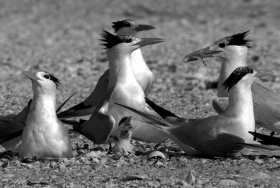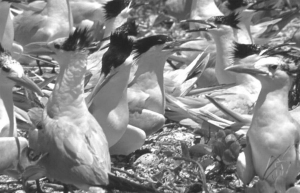
|
|||||||||||||||||||||||||||||||||||||||||||||||||||||||||||||||||||||||||||
Living on the Edge:
|
|||||||||||||||||||||||||||||||||||||||||||||||||||||||||||||||||||||||||||
 A baby Royal Tern awaits the day's catch supplied by a doting parent. Resembling a streamlined gull, the magnificient Royal Tern has an orange bill and sports a jaunty tuft of black head feathers during breeding season. |
Big and flamboyant, with a black head, dark chocolate-brown back, and orange-yellow eyes, oystercatchers are also fairly easy to spot, sharing with sun-worshipers the beaches at Fort DeSoto Park and Courtney Campbell Causeway. Like terns, skimmers, and plovers, oystercatchers are beach-nesting birds, which increasingly puts them in the line of danger.
Forced to vie for the same sandy shores that draw millions of tourists to the Sunshine State each year, Florida's beach-nesting birds are in trouble. These species literally live on the edge - the edge of the land, the edge of the water, and the edge of extinction. Three factors - weather, predators and people - impact them.
Placed just above the high tide line, often in the windrows of seaweed, flotsam, and wrack, nests are simply shallow scrapes in the sand, shells, or pebbles. Here, they are subject to washout by high tide, rogue wave or boat wake. Tropical storms bringing high water and tides, rain, erosion, and wind can wipe out entire colonies of nests. Hunters such as raccoons, foxes, armadillos, or skunks may force adults to abandon nesting sites. Eggs and hatchlings also are threatened by aerial predators like Fish Crows or Laughing Gulls.
But by far the most important cause of outright nesting failure is disturbance by people. Forcing adults to fly exposes eggs containing delicate embryos to the hot sun and almost certain death. Year after year, repeated human intrusion at nesting colonies has caused steep declines in some populations.
A real question of stark survival remains: Do Florida's beach-nesters have a future? Will nesting areas be sufficiently protected to allow these birds to breed successfully? Can enough birds hatch, grow to maturity and live to breed themselves, surviving not only human disturbance but also natural weather disasters? We know that people will continue to flock to Florida beaches in the future, but will we share our beaches with the birds?
About Beach-Nesting Birds
 American Oystercatcher nest on Tampa Port Authority Spoil Island 3D. |
Snowy Plovers are among the rarest birds in Florida, with about 130 breeding pairs in the Panhandle and fewer than 50 breeding pairs distributed from the Anclote Keys south to Naples. Snowy Plovers nest in the whitest sands, defending linear territories along the beach. Adult plovers are almost impossible to spot due to excellent camouflage; nests with eggs and young are even harder to locate. Tiny chicks can hide by crouching motionless in the shadow of a seashell. Unwitting tourists may never know they picnicked or sun-bathed on top of the nest of one of Florida's rarest birds, causing nesting failure.
Wilson's Plovers have a similar lifestyle, although with somewhat greater success because they will also nest in salt barrens, upper dunes, and other habitats less exposed to beachgoers. Willets also do a bit better, since they nest among seaside and marsh grasses, sites where blankets for sun-bathers might get wet.
Over 60 percent of Florida's estimated 2,000 Black Skimmer pairs nest at six colonies in Tampa Bay. Because they nest a bit later in the spring, establishing colonies in mid-May and June, Black Skimmer colonies often succumb to hurricane flooding in active storm years. Human disturbance caused the complete abandonment of nests at two colonies in Clearwater Harbor in 2001.
Caspian Tern numbers in Florida have increased steadily since the early 1970s, when only a handful of pairs nested in Hillsborough Bay. In 2001, two colonies in Tampa Bay supported 110 pairs, with another 206 at a new colony in Apalachicola Bay. The largest of North America's terns, Caspians nest in loose colonies on sand, laying one or two eggs. Royal Terns, slightly smaller, nest in only seven colonies statewide (5,300 pairs) and the related Sandwich Terns in just four (1,050 pairs). Royal and Sandwich Terns lay only one egg per pair; the devoted parents feed this single chick until the next spring, one of the longest instances of parental care in the bird kingdom. These three species, in contrast to many, have been increasing rapidly in the last decade due to effective protection of Tampa and Apalachicola Bay colonies. But other sites which formerly hosted Royals and Sandwich Terns on the Atlantic coast remain vacant due to chronic disturbance by boaters and their pets.
Least Terns nest in numerous sites along the coast, and have also resorted to flat, white-gravel rooftops in desperation as beach nest sites are lost to development and human impacts. Pinellas County has more rooftop colonies (over 40) than any other county in Florida, but success on rooftops can be hard to measure, and chicks can get stuck in tar, fall off rooftops, wash down storm drains in heavy summer rains, or fall prey to crows and owls.
No one really knows how many Gull-billed Terns nest in Florida, as these birds choose out-of-the-way deserted landscapes. Nests are hard to reach and monitor, but the number is low, probably less than 30 pairs. Small colonies of these insect-eaters have been found on sandy beaches, spoil areas, in phosphate mines, and on farm fields. Two decades ago 150-200 pairs nested north of Jacksonville, but no one knows where they've gone - or why.
American Oystercatchers are extremely faithful to nesting sites even after they have been disturbed, defending them against members of their own species as well as from hawks and eagles. If people approach, flamboyantly colored adult oystercatchers will walk away from nests, trusting the excellent camouflage of the speckled eggs to protect them. But in the blazing hot spring and summer midday sun, the young can die of heat exposure in about 20 minutes without a parent's protective shade.
Laughing Gulls may not be so common after all. While numbers are relatively high, populations have declined 75 percent in Florida to about 18,000 pairs since 1980 - and nesting sites are few. Almost 75 percent of Florida's Laughing Gulls breed in the Tampa Bay area in dense grass colonies at just four sites. With so few sites, human intrusion can actually negatively impact statewide nesting success of this relatively common species.
| Species | Listing | Nesting Pairs in Fla. | Nesting Sites in Fla. |
| Masked Booby | About 10-20 | Hospital Key* | |
| Snowy Plover | T | Approx. 180 | 130 on Panhandle, 50 on west coast |
| Wilson's Plover | Unknown but > 300 | ||
| American Oystercatcher | SSC | 390 | Linear territories on beaches & spoil islands |
| Willet | Unknown | ||
| Laughing Gull | 18,000-20,000 | 15 colonies | |
| Gull-billed Tern | Less than 30 | 3 colonies | |
| Caspian Tern | 310 | 3 colonies | |
| Royal Tern | 5,300 | 7 colonies | |
| Sandwich Tern | 1,050 | 4 colonies | |
| Roseate Tern | T | About 300 | 2 - Pelican Shoals, Marathon rooftop |
| Least Tern | T | 6,000 on rooftops; 2,000 on the ground |
195 known rooftop sites, 65 known ground sites |
| Bridled Tern | Less than 10 | Pelican Shoals | |
| Sooty Tern | 35,000 | Bush Key* | |
| Brown Noddy | 2,500 | 2 - Bush Key, Long Key* | |
| Black Skimmer | SSC | 2000 | About 25 colonies |
| 2001 Data | *Dry Tortugas National Park | Fla. Fish & Wildlife Consevation Commision Listing: T=Threatened SSC=Species of Special Concern |
|
Elegant News!

Photo: Rich Paul
Birdwatching on Tampa Bay
- DolphinQuest EcoTours
- Two-hour excursions in Hillsborough Bay aboard the aquarium's 64-foot catamaran, "Bay Spirit," passing by Audubon's Alafia Bank Bird Sanctuary and spoil islands.
- Where:
- Located behind the Florida Aquarium
701 Channelside Drive, downtown Tampa - When:
- Departs several times each day
- Cost:
- $15/adults, $10/children; under age 3 free
Info @ 813-273-4000
- Shell Key Shuttle
- Visits lovely barrier island, home of nesting Oystercatchers, Laughing Gulls, Snowy Plovers, Least Terns, Willets and Black Skimmers.
- Where:
- Mary Pier in Pass-A-Grille,
South St. Pete Beach - When:
- Daily, 10, noon and 2;
sunset cruises available - Cost:
- $14/adult; $7/children
Info @ 727-360-1348 or
www.shellkeyshuttle.com
|
What you can do: Fortunately, there are ample ways for beach-goers to enjoy the magnificent spectacle of Florida's beach-nesting birds without harming them:
|
Ann Paul is assistant manager of the Florida Audubon Society's Coastal Islands Sanctuaries, including the Alafia Bank Sanctuary in Tampa Bay, Washburn Sanctuary in Terra Ceia Bay, and Cortez Key in Sarasota Bay.